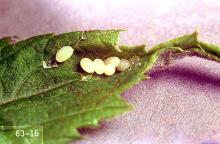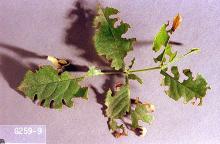Sciopithes obscurus
Pest description and crop damage Adults are predominantly gray with a wavy brown line across the wing covers. They are about 6-8 mm in length. Larvae resemble strawberry root weevil larvae in appearance and life cycle, and also feed on roots. Adults feed on foliage; they cause little damage to leaves but may contaminate fruit in mechanically harvested fields.
Biology and life history Weevils overwinter as larvae in the soil. Feeding may occur throughout mild winters. In April-June, larvae pupate, and adult emergence occurs. Unlike other weevil species found in caneberries, the obscure root weevil is known to stay in the plant foliage during the day and remain inactive, becoming active and feeding at night. However, some obscure root weevils do migrate to the soil during the day and climb up to feed on foliage at night. Adult weevils cannot fly, but walk or are carried from one location to another by equipment. All adults are females capable of laying hundreds of eggs.
Eggs are laid in clusters in or on the soil from June to September. The eggs hatch and the larvae immediately wriggle through the soil to begin feeding on roots. There is one generation per year.
Scouting and thresholds Observe leaves for notching from adult feeding in early summer. Controls should be undertaken soon after adult feeding is observed, but before egg laying occurs, generally about four weeks. Presence of adults can be confirmed by night inspection of foliage on warm, still evenings. Or, look for adults in the day in the foliage or by looking through debris at the base of the plant for those weevils that have migrated. Wrap the trunks of the plant with cardboard and check underneath in the early morning.
Management-biological control
- beneficial nematodes-Nematodes, such as Heterorhabditis spp. and Steinernema spp., have shown some effectiveness in controlling larvae when applied as label directs, as a drench in the fall. Nematodes must be placed in the root zone where weevil larvae are present.
See also:
Management-cultural control
Cultivating soil in April-May can eliminate overwintering larvae before planting. Use a cereal cover crop, as small grains are not a host for root weevils.
Management-chemical control: HOME USE
There are no products available for home garden use.
Management-chemical control: COMMERCIAL USE
Apply foliar sprays at night, usually between dusk and midnight, on warm, calm evenings when adult weevils are on foliage and feeding. Control is usually poor when applied by day or on cold or windy nights.
- azadirachtin (Neemix, Aza-Direct, Ecozin Plus and other brands)-Consult label for rate. Some formulations are OMRI-listed for organic use.
- Beauveria bassiana (Mycotrol and other brands)-Consult label for rate. Some formulations are OMRI-listed for organic use.
- bifenthrin (Fanfare and others) at 0.05 to 0.10 lb ai/A. PHI 3 days. Do not apply more than 0.2 lb ai/A per season. Restricted use pesticide.
- cyantraniliprole (Exirel) at 0.088 to 0.133 lb ai/A. PHI 3 days. Adult control. Do not apply more than 0.4 lb ai/A per year. Highly toxic to bees; do not apply during bloom.
- esfenvalerate (Asana XL and others) at 0.05 lb ai/A. PHI 7 days. Apply as a pre-bloom or post-bloom spray only. Remove bees prior to application. Asana can act as a bee repellent; do not apply within 7 days of pollination. For maximum safety to bees, apply in the evening after sunset. Label allows use for weevil control in Washington and Oregon only. Because of pollinator hazard, WSU entomologists do not recommend its use on red raspberry. Restricted use pesticide.
- fenpropathrin (Danitol) at 0.2 to 0.3 lb ai/A. PHI 3 days. Do not exceed 0.6 lb ai/A peer season. Highly toxic to bees. Restricted use pesticide.
- malathion-Consult label for rates. PHI 1 day. EC formulations may leave an oily film on fruit when used near or during harvest. Toxic to bees; do not apply when bees are foraging.
- thiamethoxam (Actara) at 0.047 lb ai/A. PHI 3 days. Adult control. Do not apply during bloom.
- zeta-cypermethrin (Mustang) at 0.05 lb ai/A. PHI 1 day. Restricted use pesticide.




